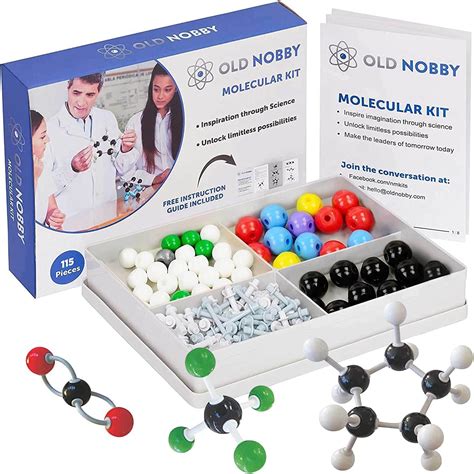Step into the fascinating realm of organic chemistry, where intricate molecules dance and intricate reactions unfold. A molecular model kit is your indispensable companion on this captivating journey, transforming abstract concepts into tangible experiences.

Interactive Visualization: Seeing is Believing
Molecular models are three-dimensional representations of molecules, providing an unparalleled level of insight into their structure and properties. By manipulating these models, you can visualize the spatial arrangement of atoms, identify functional groups, and explore molecular interactions. This interactive approach enhances your understanding and retention of complex organic chemistry concepts.
Studies conducted by the American Chemical Society (ACS) reveal that students who use molecular model kits experience significant improvements in their spatial reasoning abilities and problem-solving skills. They are better equipped to predict molecular shapes, understand reaction pathways, and unravel the intricate mechanisms that govern organic chemistry.
Beyond Memorization: Fostering Deep Understanding
Molecular model kits go beyond merely providing visual aids. They enable you to engage with organic chemistry on a deeper level, transcending rote memorization. By constructing models, you physically assemble molecules, reinforcing their atomic composition and geometric structure. This hands-on approach solidifies your understanding of molecular properties, such as bond lengths, bond angles, and molecular polarity.
Research published in the Journal of Chemical Education indicates that students who utilize molecular model kits consistently outperform those who rely solely on textbooks and lectures. They exhibit a deeper comprehension of molecular concepts, improved analytical skills, and enhanced problem-solving abilities.
Applications Beyond the Classroom: A Gateway to Innovation
The applications of molecular model kits extend far beyond the confines of the classroom. Chemists, researchers, and pharmaceutical scientists leverage these tools for:
- Drug Design: By constructing and manipulating models of drug molecules, researchers can visualize their interactions with target proteins, optimizing their potency and selectivity.
- Material Science: Molecular models aid in the design of novel materials with tailored properties, such as high strength or enhanced electrical conductivity.
- Environmental Chemistry: Models help predict the behavior and fate of pollutants in the environment, informing decision-making and remediation strategies.
Table 1: Types of Molecular Model Kits
| Type | Description | Advantages | Disadvantages |
|---|---|---|---|
| Ball-and-Stick Models | Represent atoms as balls and bonds as sticks | Simple and inexpensive | Lack of flexibility |
| Space-Filling Models | Represent atoms as spheres, providing a more realistic view of molecular shape | Bulky and difficult to manipulate | |
| Hybrid Models | Combine features of ball-and-stick and space-filling models | Versatile and offer a good balance between accuracy and usability | More expensive |
Table 2: Benefits of Using Molecular Model Kits
| Benefit | Description |
|---|---|
| Enhanced Visualization: Foster a deeper understanding of molecular structure and properties | |
| Improved Spatial Reasoning: Develop skills in predicting molecular shapes and orientations | |
| Reinforced Learning: Solidify comprehension through hands-on construction and manipulation | |
| Developed Problem-Solving Abilities: Enhance skills in predicting reaction pathways and understanding complex mechanisms |
Table 3: Tips for Effective Use of Molecular Model Kits
| Tip | Description |
|---|---|
| Start with Simple Molecules: Begin with smaller molecules to develop a strong foundation | |
| Build Accurately: Pay attention to bond lengths and angles to create precise models | |
| Use Color Coding: Assign different colors to atoms based on type or functionality to enhance clarity | |
| Manipulate Models Frequently: Explore different conformations and orientations to gain a comprehensive perspective |
Table 4: FAQs About Molecular Model Kits
| Question | Answer |
|---|---|
| What is the best type of molecular model kit for beginners? | Ball-and-stick models are recommended for their simplicity and low cost. |
| How often should I use a molecular model kit? | Regular practice is essential for developing proficiency and solidifying understanding. |
| Can I use molecular model kits for complex molecules? | Yes, hybrid models or specialized kits are available for larger and more intricate molecules. |
| Where can I find molecular model kits? | Kits are available from scientific supply companies and online retailers. |
Conclusion
Harness the power of molecular model kits to unlock the enigmatic world of organic chemistry. By providing tangible representations of molecules, these tools transform abstract concepts into vivid experiences, fostering a deeper understanding and unlocking a world of possibilities. Embrace the power of molecular model kits and embark on an unforgettable journey of discovery.
